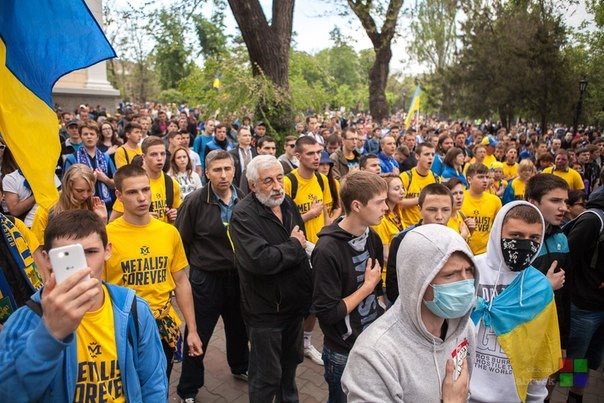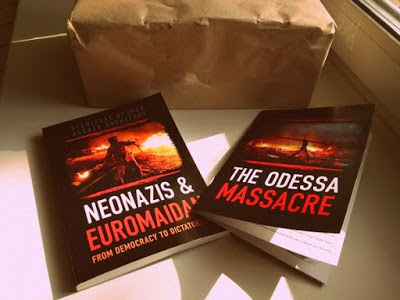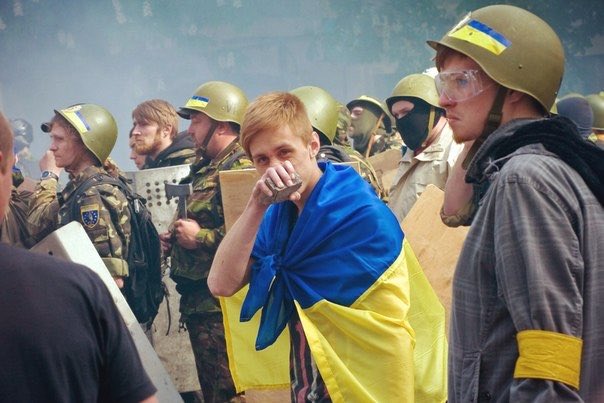Russia's full-blown invasion of Ukraine would have been impossible without a targeted propaganda campaign to dehumanize and demonize Ukrainians. This campaign of hatred, centered around Russia's Big Lie of "Ukrainian Nazis," has a crown jewel: the tragic events in Odesa on 2 May 2014, which Russian media exploited to fuel hatred in the Russian public and justify Russia's war against Ukraine, writes Tetiana Herasymova, coordinator of the "2 May" group, reflecting on the ninth anniversary of the tragedy.
The "2 May" group, an independent initiative of human rights activists and journalists, united nine years ago to establish the truth of what happened on that fateful day in Ukraine's seaside city of Odesa. Then, in the wake of Ukraine's Euromaidan Revolution, which saw the Moscow-aligned President Yanukovych fleeing to Russia, a confrontation between the pro-Ukrainian and pro-Russian Odesites ended in a fire in the local Trade Unions building and claimed 48 lives.
According to the group, which in 2016 released a film based on witness testimonies and expert analyses, this tragedy prevented the creation of a Kremlin puppet state in Odesa. Its failure was a major setback for Russian attempts to tear away eight south-eastern regions of Ukraine.
The Odesa tragedy: bloody trail of the “Russian spring” – new film by human rights group
However, in the world of Russian propaganda, the tragedy was dubbed the 2014 "Odesa massacre" or "Odesa Khatyn" and became a staple of Russian propaganda. According to Herasymova, Russian media has consistently pushed a distorted version of events, claiming that Ukrainian "fascists" set fire to the Trade Union House, deliberately burning innocent people alive.
This narrative has been discredited by numerous investigations, including an investigative committee of Ukraine's Parliament, the International Advisory Panel of the Council of Europe
, and the "2 May" group themselves. These investigations dub the official position of Ukraine's General Prosecutor's Office of Ukraine in April 2015:
"Law enforcement did not provide proper public order protection, leading to a clash between the column holding the 'For the Unity of Ukraine' march and an organized group of individuals attempting to disrupt the march in the vul. Hretska area in Odesa. As a result, mass clashes began in the Hretska Ploshcha area, and after the football match at the Kulikovo Field near the Trade Unions House, the clashes spread significantly and temporarily went out of control of the law enforcement agencies. The investigation found that both sides used incendiary mixtures, including inside the Trade Unions House, which led to the fire, and the barricade set up near the stairs contributed to the fire's spread. No evidence of a planned fire at the Trade Unions House was found. The fire was a consequence of the use of incendiary mixtures by the participants of the mass riots. As a result of the riots, 18 people were injured by firearms in the Hretska Square area, with six fatalities. During the fire at the Trade Unions House, 42 people died, with 10 suffering injuries due to falls while trying to escape the fire, and 32 individuals perished due to carbon monoxide poisoning and combustion products. In total, over 250 people were injured during the mass riots."
However, the journalists and experts of the "2 May" group maintain that what happened on that day was no ordinary clash between two groups, but an attempt to overturn constitutional order in Ukraine, to seize power in the Odesa Oblast and turn it into the likes of Russia's puppet republics in Donbas. That this didn't happen was a miracle, as well as the huge merit of ordinary Odesites -- Euromaidan participants and football fans with plywood shields who stood up against the real fascists, Herasymova writes.

Facts mattered not to the Russian propagandists, who created the myth of an 2014 "Odesa massacre" and diligently exploited the tragedy as a tool for injecting hatred like a drug into the Russian public.
Its role was to reinforce Russia's Big Lie created during the Euromaidan Revolution -- of a Nazi Ukraine that existed only in the information space of Russian propagandists. By repeating the Big Lie ad nauseam (one of the key tactics of Spetspropaganda, approved by Joseph Goebbels himself), Russian propagandists zombified the Russian populace into believing that a "gang of neo-Nazis" had captured power in Ukraine -- an assertion divided from reality, made viable only thanks to the Russians' overwhelming ignorance 0f reality in Ukraine.
How the 2014 "Odesa Massacre" myth was built
According to Tetiana Herasymova, the myth became an axiom due to incessant repetition by Russian state media.
The next day after the clashes, the Russian newspaper "Vesti" published the propagandistic article "Odesa Khatyn," which falsely asserted that the essence of 2 May was that "innocent people were forced into the Trade Union Building and burned alive." In itself, this is an important propaganda strategy, also approved by Goebbels: making sure that your propaganda reaches the target quicker than your enemy's.
The myth was further spun just one week after the tragedy, on 9 May 2014 in Athens, where the books "Neonazism & Euromaidan: From Democracy to Dictatorship" by A. Kochetkov, who was paid RUB 5.7mn by the Russian government, and "Odesa Massacre" by S. Byshkov were presented.

The authors stated: "The Odesa massacre was organized in the same way that Ukrainian Nazi thugs recruited by Hitler's forces from Stepan Bandera's Ukrainian Nationalist Organization (OUN) had brutally massacred the entire population of the Belarusian village of Khatyn in March 1943."
This refers to a true historical event; however, its memory is manipulated, underscoring the continuity of Russian propaganda over the decades.
Villagers in Katyn were indeed executed
in retribution for partisan acts against the Nazis; a German battalion carried out the incident and indeed involved Ukrainian collaborators; however, they were not from the OUN, a scarecrow for Russian propaganda. Hundreds of Belarusian villages were burned to the ground in the way that Khatyn was, but Khatyn rose to the status of a mythological symbol of all German atrocities against civilians; as one version has it, it was chosen to conceal the Soviet execution of Polish officers in Katyn by trumping it with war crimes committed against Soviets in an almost identically-sounding location, "Khatyn."
The allusion fit Russia's Big Lie -- that post-Euromaidan Ukraine is supposedly dominated by Nazis -- like a glove. The "Odesa Khatyn" word combination became an axiom of Russian propaganda, regurgitated ad nauseum by endless Russian blogs, newspapers, and websites. By loading it with ever more details, scary photographs, and witness interviews, Russian propagandists created the mental virus "Odesa Khatyn - Ukrainian Nazis," with the sole goal of dehumanizing Ukrainians, so it would be easier to kill them, Herasymova writes.
Furthermore, entire Russian TV shows, documentaries, and films were built around this false narrative, including works by Arkadiy Mamontov, who has specialized in the "Odesa Massacre" on Russian TV. Herasymova argues that the goal of these propagandist works is not to establish the truth but to fuel hatred and demonize Ukraine, portraying it as a nation controlled by Nazis and the US.
In this, Russian propagandists had great success: show by show, utilizing mental viruses such as the "Odesa Massacre," they constructed the alternative reality of a "Nazi Ukraine." In a 2019 report by Russian media expert Igor Yakovenko, a content analysis of a single episode of the program "Sunday Evening with Vladimir Solovyov" revealed that the term "Nazi Ukraine" was used 32 times in just over an hour.
Yakovenko concluded: "The war against Ukraine and the killing of Ukrainians are morally approvable actions for Russians thanks to the main cliché drilled into their minds: "UKRAINE IS A NAZI STATE."
"If we compare hatred to a hard drug with which the Russian public has been pumped over the past nine years, then the 'Odesa Massacre' has become one of the main syringes for injecting this drug," Herasymova states.
The "Odesa Massacre" myth's prominent role in driving Russia's Ukraine-hatred was highlighted in the fact that on 21 February 2022, three days ahead of the full-blown invasion, Putin promised to punish those guilty in the deaths of people in Odesa, in a video address to Russians.
However, now the myth is nowhere to be seen. It has already played its role by making the war against Ukraine morally acceptable for the Russians. Now, there is no need to cover up the real goal of the war -- to destroy the entire Ukrainian nation and state, Herasymova sums up.
Related:
- The Odesa tragedy: bloody trail of the “Russian spring” – new film by human rights group
- Four towers of Kremlin propaganda: Russia, Ukraine, South, West
- Seven strategies of domestic Russian propaganda
- A guide to Russian propaganda. Part 6: Spetspropaganda, the secret Soviet art of brainwashing

